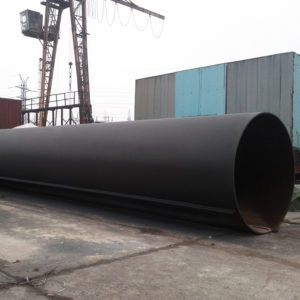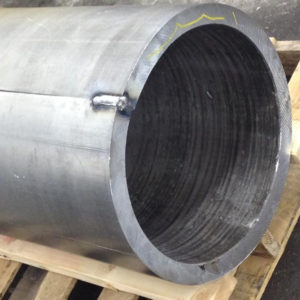The Application of Miniature Steel Pipe Pile and Vertical Composite Soil Nailing Wall in a Deep Foundation Pit
1.0 Introduction
In the foundation pit support engineering, a variety of composite soil nailing wall support structures have been developed on the foundation of soil nailing wall. There are several common support structures used in Beijing, including soil nailing and prestressed anchor, soil nailing and mixing piles, soil nailing and miniature steel pipe piles. In practical foundation pit supporting projects, it is often to face the case like soil layer with poor stability(e.g., silt soil, sand, and pebbles), deep foundation pit, restrictions of the surrounding environment, limited construction area. For this case, the combined use of soil nailing, prestressed anchor and miniature steel piles to form miniature steel pipe piles vertical composite soil nailing wall is a solution. In this structure, as advanced support, miniature steel piles improves soil self-reliance stability. The prestressed anchor can effectively control slope surface displacement. In this case, the safety of the foundation pit and periphery environment are guaranteed, as well as reducing the cost of the project.
2.0 Project case
2.1 Project profile
It is a project located in Shibaidian Town, Chaoyang District, Beijing. The area of this foundation pit is about 20,000m^2, and the depth of this pit is 14.17m. The layer of the engineering site within the influence range of foundation pit excavation is mainly distributed as follows:
The first is Artificial accumulation layers, which includes:
- Clayey silt filling with the thickness of 3.7m, yellow-brown, wet and loose.
- Brick rubbish layer with the thickness of 2. 50m, variegated, wet, loose.
The following layer is fine-grained strata:
- Sandy clay, clayey silt, the thickness of 0.5 to 5.15m, brown-yellow, slightly wet, dense. It contains mica, iron oxide and a small amount of loess-doll.
- Silt, fine sand, the thickness of 1.50 to 3.10m, brown-yellow, wet, medium density. It contains quartz, feldspar, mica and iron oxide
- Silty clay, the thickness of 3.80 to 6.00m, brown-yellow, hard plastic. It contains mica, iron oxide and a small amount of loess-doll.
- Fine sand, the thickness of 0. 70 to 7. 00m, brown-yellow, wet, dense. It contains quartz, feldspar, mica and iron oxide.
- Sticky silt, the thickness of 0.70m, brown-yellow, wet, dense. It contains mica, iron oxide and a small amount of ginger stone.
- Heavy silty clay, silt, the thickness of 1.70 to 4.00m, brown-yellow, plastic. It contains mica, iron oxide and a small amount of loess-doll, as well as part of a thin layer of silty clay.
- Medium sand, the thickness of 4.80 to 6.70m, brown-yellow, wet-saturated, dense. It contains quartz, feldspar mica and iron oxide.
2.2 Design of dewatering in the foundation pit
For the composite soil nailing wall supporting structure, the effective control of groundwater is one of the keys to the success of the whole foundation pit project. In this foundation pit, the upper stagnant water level is high, and the upper soil layer within the excavation depth, such as silt and clay, has a poor performance in permeability. Therefore, the dewatering scheme combining pipe well dewatering and drainage is adopted. Precipitation wells are 600mm in diameter, 8m in spacing and 26m in depth. For possible seepage on the slope, drainage pipe can be added on the shotcrete panel based on the actual situation. At the same time, in order to avoid the rainwater flowing into the foundation pit and effectively remove the water in the pit, open drainage ditches are set on the top of the slope and at the bottom of the pit.
2.3 The design for miniature steel pipe pile and vertical composite soil nailing wall
There are unprotected open cut excavation space in the east, west and north of this foundation pit. Because of the construction situation, the composite soil nailing wall support form is adopted, which is the combination of soil nailing wall and prestressed anchor. The distance between the south side of foundation pit and road is 2.8m, and there is not enough space for unprotected open cut excavation. In view of this situation, the south side adopts the support form of miniature steel pipe pile and vertical composite soil nailing wall. There are six soil nails, and three prestressed anchor bars are set on the south side. Channel steel and jetted reinforced concrete beam are used as the waist beam to enhance the overall stiffness of the soil nail wall, preventing cracking and external bulge from ensuring the safety of the foundation pit. The parameters of the miniature steel pipe pile are as follows:
- Borehole Ø150 with the hole depth of 15.5m and pile spacing of 0.5m.
- Insertion of a Ø50 steel pipe into the hole, with the wall thickness greater than 2.5mm and pipe length of 15.0m. Two Ø20 are used to connect the top of the pipe.
- The miniature borehole is filled by P.SA32 cement slurry with a water-cement ratio of 0.45-0.5 and fills 2~7mm gravel appropriately.
2.4 Construction difficulties and solutions
- It is difficult to control the piling quality of miniature steel pipe piles because of the pile. Since the length is relatively long, the verticality must be controlled within 1% to avoid adverse grade. Therefore, during the drilling process, the construction personnel should pay attention to the guidance of the drill pipe. They need to analyze the cause immediately when encountering deviation and bending. Also, they have to take measures to deal with it to ensure the verticality of the miniature steel pipe pile. In addition, the diameter of the miniature steel pipe pile is the only 150mm, which is easy to cause hole collapse in the process of hole formation. Therefore, after drilling to the bottom of the hole, the drilling rig lifts the hole from the grouting side of the drill pipe, effectively preventing hole collapse. In the past, the usual construction method for steel pipe piles is only injection mud without gravel filling. After earth excavation, the cement spalling around the steel pipe, and the retaining soil effect of micro piles is significantly weakened. In this project, crushed stone is filled between the steel pipe and the hole wall, and steel bar is inserted and rammed while grouting is carried out. The actual effect proves that no peeling occurs after adding gravel, which guarantees the effective pile diameter of 150mm, thus improving the self-supporting stability of soil layer and effectively improving the stability of composite soil nail wall slope.
- The quality of anchor bolt construction is difficult to control in soil layer containing stagnant water. Whether the construction effect of three bolts can reach the designed bearing capacity plays a very important role in the overall stability of the slope. Since the upper soil layer within the excavation depth is a weak permeable layer such as silt and clay, the permeability is weak, and it is impossible to dry the soil layer by relying on dewatering entirely. If the construction method of the conventional bolt is adopted, the strength of the anchor is challenging to meet the design requirements, thus reducing the bearing capacity of bolt. In this project, the secondary high-pressure splitting grouting process is adopted. The PVC pipe is fixed at the positioning frame centre when the bolt body is made. The secondary high-pressure grouting is carried out after the completion of the first grouting for 8-12h, and the grouting pressure is maintained at 1.0 ~2.0MPa.
- For the vertical slope rich in sand, it is easy to collapse in a small scope after excavation. In the process of excavation, the test section (15m long) shall be pre-excavated first. If the slope collapses in a small scope after excavation, this slope shall be backfilled immediately.
- Abundant stagnant water in the sand layer is easy to cause flowing sand. In the process of vertical soil nailing wall excavation, unprotected open cut excavation with the slope of 1:1 is adopted when facing abundant stagnant water. The excavation is carried out until it inserts the next relatively impermeable layer 1m. After the stagnant water in the sand, the layer is naturally dried, the excavation of soil nailing wall is carried out according to the scheduled procedure.
3.0 Conclusion
(1) Miniature steel pipe pile is used as advance support to solve the self-supporting stability of soil layer after earthwork excavation. It also ensures enough time for earth-nailing wall construction after earthwork excavation, so that the vertical composite earth-nailing wall support structure can be applied to deep foundation pits.
(2)In the deep foundation pit support engineering, the miniature steel pipe pile and vertical composite soil nailing wall should be used together with the slope horizontal (vertical) strengthening body (shotcrete beam, and type steel beam.) to enhance the strength of the soil nailing wall. It prevents the external bulge and cracking of the soil nailing wall caused by the insufficient strength of the surface layer.




